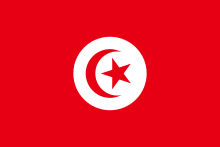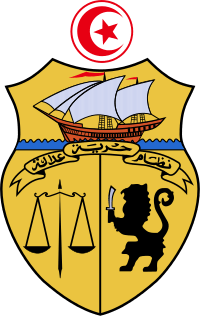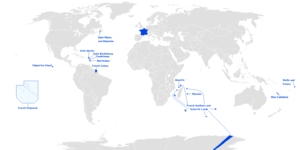French protectorate of Tunisia
| French protectorate of Tunisia | ||||||||||
| Protectorat français de Tunisie الحماية الفرنسية في تونس | ||||||||||
| Protectorate of France | ||||||||||
| ||||||||||
| Anthem (instrumental only) | ||||||||||
 Tunisia (dark blue) French possessions in Africa (light blue) 1913 | ||||||||||
| Capital | Tunis | |||||||||
| Languages | French Italian Berber languages Arabic Tunisian Arabic Judeo-Tunisian Arabic Turkish | |||||||||
| Religion | Roman Catholicism Judaism Sunni Islam | |||||||||
| Government | Constitutional monarchy | |||||||||
| Bey | ||||||||||
| • | 1859–1882 | Muhammad III as-Sadiq (first) | ||||||||
| • | 1943–1956 | Muhammad VIII al-Amin (last) | ||||||||
| Resident-General | ||||||||||
| • | 1885–1886 | Paul Cambon (first) | ||||||||
| • | 1954–1955 | Pierre Boyer de Latour du Moulin (last) | ||||||||
| High Commissioner | ||||||||||
| • | 1955–1956 | Roger Seydoux Fornier de Clausonne | ||||||||
| History | ||||||||||
| • | Treaty of Bardo | May 12, 1881 | ||||||||
| • | Battle of Tunisia | 1942–1943 | ||||||||
| • | Independence | March 20, 1956 | ||||||||
| Area | ||||||||||
| • | 1881 est. | 155,000 km² (59,846 sq mi) | ||||||||
| Population | ||||||||||
| • | 1939 est. est. | 2,600,000 | ||||||||
| Density | 16.8 /km² (43.4 /sq mi) | |||||||||
| Currency | Tunisian rial (until 1891) Tunisian franc (1891–1958) | |||||||||
| ||||||||||
The French protectorate of Tunisia (French: Protectorat français de Tunisie; Arabic: الحماية الفرنسية في تونس al-Ḥimāya al-Fransīya fī Tūnis) was established in 1881, during the French colonial Empire era, and lasted until Tunisian independence in 1956.
Tunisia formed a province of the decaying Ottoman Empire but enjoyed a large measure of autonomy under the bey Muhammad III as-Sadiq. In 1877, Russia declared war on the Ottoman Empire. Russian victory foreshadowed the dismemberment of the empire, including independence for several Balkan possessions and international discussions about the future of the North African provinces. The Berlin Congress of 1878 convened to resolve the Ottoman question. Britain, although opposed to total dismantling of the Ottoman Empire, offered France control of Tunisia, in return for Cyprus. Germany, seeing the French claim as a way to divert French attention from revengeful action in Europe (where France had suffered defeat at Prussian hands in 1870–1) and little concerned about the southern Mediterranean, agreed to allow France overlordship in Tunisia. Italy, which had economic interests in Tunisia, strongly opposed the plan but was unable to impose its will.
The French presence in Tunisia came five decades after their occupation of neighboring Algeria, the time when the French were still inexperienced about and lacked the knowledge of how to develop a colony.[1] Both of these countries had been former possessions of the Ottoman Empire for three centuries, yet each had long ago attained political autonomy from the Sultan in Constantinople. Before the French arrived, Tunisia had begun a process of modern reforms, but financial difficulties mounted until the installation of a commission of European creditors. After their occupation the French government assumed Tunisia's international obligations. Major developments and improvements were undertaken by the French in several areas, including transport and infrastructure, industry, the financial system, public health, and administration. Yet French business and its citizens were favored, not to the liking of Tunisians. Their preexisting national sense was early expressed in speech and in print; political organization followed. The independence movement was already active before World War I, and continued to gain strength against mixed French opposition. Its ultimate aim was achieved in 1956.
Background
Tunisia before the French protectorate
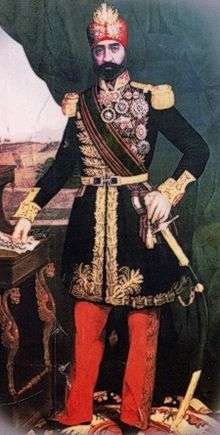
Part of a series on the |
||||||||||||
|---|---|---|---|---|---|---|---|---|---|---|---|---|
| History of Tunisia | ||||||||||||
| Prehistoric | ||||||||||||
|
||||||||||||
| Ancient | ||||||||||||
|
||||||||||||
| Early Islamic | ||||||||||||
|
||||||||||||
| Medieval | ||||||||||||
|
||||||||||||
| Early modern | ||||||||||||
|
||||||||||||
| Modern | ||||||||||||
|
||||||||||||
|
| ||||||||||||
Before French occupation, Tunisia formed a province of the Ottoman Empire, but enjoyed a large measure of autonomy. The Ottoman ruler had placed a governor, a pasha, in charge of the Tunisian province. However, this pasha quickly lost control to the military commander, the dey. And the dey, in his turn, had been ousted by a civil administrator, the bey. The Sultan of the Ottoman Empire subsequently elevated the bey to the rank of dey and pasha, so that the decorum was satisfied all round. In 1705, the office fell into the hands of Al-Husayn I ibn Ali at-Turki, who founded a dynasty that was to reign over Tunisia for two and a half centuries. When European influence continued to grow during the second half of the 19th century, Tunisia became a de facto independent state.[2] The bey had his own army and navy, struck his own coins, declared war and peace, maintained separate diplomatic relations and signed treaties.[3] Nevertheless, the bey was officially a Turkish governor, invoked the Sultan in his prayers, and on first taking office had to apply for a firman, that is official recognition by the Sultan.[4]
This complicated matters of affairs was used by the European powers seeking influence in Tunisia, according to historian Henk Wesseling "[...] this state of affairs, however complicated, was not without practical benefits, because [the European Powers] could treat the bey, at will, either as an independent ruler or as a vassal of the Porte."[4]
From 1859 to 1882 Tunisia was ruled by the bey Muhammad III as-Sadiq, and the powerful Prime Minister, Mustapha Khaznadar, who according to Wesseling "had been pulling the strings ever since 1837."[5] Khaznadar was minister of finance and foreign affairs and was assisted by the interior, defence, and naval ministers. In 1864 Tunisia was granted a constitution with a clear division of ministerial powers and responsibilities, but in practice Khaznadar was the absolute sovereign.[5] He followed a policy of reforms, that is, of economic development, aimed at improving the infrastructure as well as the means of communication, the armed forces, and so on. The Tunisian economy did not, however, provide enough money to pay for it all, at least not after deduction of government expenses.[6] Central administration, however, was weak. Tax collection was devolved onto tax-farmers, and only one-fifth of the revenues ever reached the national treasury. Many hill tribes and desert nomads lived in quasi-independence. Economic conditions deteriorated through the 19th century, as foreign fleets curbed corsairs, and droughts perennially wreaked ill effect on production of cereals and olives. Because of accords with foreign traders dating back to the 16th century, custom duties were limited to 3 per cent of the value of imported goods; yet manufactured products from overseas, primarily textiles, flooded Tunisia and gradually destroyed local artisan industries.
In 1861, Prime Minister Mustapha Khaznadar made an effort to modernise administration and tried to increase revenues by doubling taxes. The major effect, only fully felt by 1864, was widespread rural insurrection, coupled with great hardship for the general population. The government had to negotiate a new loan from foreign bankers. In 1867, an attempt to secure money failed; government revenues were insufficient to meet annual interest payments on the national debt. Tunisia plunged towards bankruptcy. Two years later France, Italy and Britain set up an international finance commission to sort out Tunisia’s economic problems and safeguard Western stakes. Their actions enjoyed only partial success, largely because of opposition from foreign traders to increase in the customs levy. In 1873, Khaznadar again undertook reforms and attacked the widespread financial abuses within the bureaucracy. The result were initially promising, but bad harvests and palace intrigues led to his downfall.
The ruler of Tunisia reigned over what in fact over what was a modest territory, whose southern borders were vague and inconsequential, losing themselves into the Sahara.[4] To the east lay Tripolitania, another province of the Ottoman Empire, which had also made itself practically independent until Sultan Mahmud II successfully restored his authority by force in 1835.[4] The Bey of Tunisia became worried of the strengthening of Ottoman authority in the east, and was therefore not too unhappy in 1830 when another country, France, had settled on his western borders. According to Wesseling, the bey considered the reconquest of his country by the Porte a much greater threat than a possible conquest by France.[4]
At the time Tunisia had just over a million inhabitants. Half of these were sedentary farmers who lived mainly in the northeast; the other half were nomadic shepherds who roamed the interior. There were several towns, including Tunis with nearly 100 000 inhabitants, and Kairouan with 15 000, where traders and artisans were active, despite being severely affected by foreign competition. The traditional Tunisian textile industry couldn't compete with imported goods from industrialized Europe. The financial world was dominated by Tunisian Jews, while a growing number of Europeans, almost exclusively Italians and Maltese, settled in Tunisia. In 1870, there were 15 000 of them.[7] The economic situation of Tunisian townsmen may accordingly have been under pressure, but it was flourishing in comparison with that of the fellahin, the peasants who laboured under a whole series of taxes and requisitions. In the disastrous years of 1867 and 1868, famines were added to these, the result of crop failure, as well as epidemics — first cholera, then typhus — killed many thousands. During this period some 20 percent of the population perished.[5]
These circumstances made the Tunisian government unable, despite all levies and demands, to collect the tax revenues they deemed necessary to modernise Tunisia.
Decline of the Ottoman Empire
In 1877, Russia declared war on the Ottomans. Russian victory foreshadowed the dismemberment of the already declining Ottoman Empire, including independence for several Balkan possession and international discussions about the future of the North African provinces.
In 1879, when Charles de Freycinet became prime minister of France and Admiral Bernard Jauréguiberry his minister of the navy,[note 1] an new French colonial policy was launched: the French government began to lend more active support to military expansion in western and northern Africa.[8]
What happened in North Africa was caught in the spotlight of world politics. Every action affected the complicated European balance of power, a balance which had been radically altered by the Franco-Prussian War of 1870, which had ended in French defeat. After it, the political map of Europe was radically altered: Imperial Germany had become the most important power in continental Europe.[9]
The Ottoman Empire formally protested the French incursion into Tunisia, but did nothing else. It never officially recognised the loss of Tunisia, preferring to treat it as a "principality" (emaret, an autonomous province) of the empire on a 1905 map of Ottoman territories in Africa.[10]
Congress of Berlin
The Congress of Berlin, held in 1878, convened to discuss the Ottoman Empire, the "sick man" of Europe, following its decisive defeat by Russia, with a focus on its Balkan possessions. At the Congress arrangements were also understood, e.g., in Germany and Britain, which allowed France to incorporate Tunisia. Italy was promised Tarabulus in what became Libya. Britain supported French influence in Tunisia in exchange for its own protectorate over Cyprus (recently "purchased" from the Ottomans), and French cooperation regarding a nationalist revolt in Egypt. In the meantime, however, an Italian company apparently bought the Tunis-Goletta-Marsa rail line; yet French strategy worked to circumvent this and other issues created by the sizeable colony of Tunisian Italians. Direct attempts by the French to negotiate with the Bey their entry into Tunisia failed. France waited, searching to find reasons to justify the timing of a pre-emptive strike, now actively contemplated. Italians would call such strike the Schiaffo di Tunisi.
In northwest Tunisia, the Khroumir tribe episodically launched raids into the surrounding countryside. In the spring of 1881, they raided across the border into French Algeria. France responded by invading Tunisia, sending an army of about 36,000. Their advance to Tunis was rapidly executed. The Bey was soon compelled to come to terms with the French occupation of the country, in the first of a series of treaties. These documents provided that the Bey continue as head of state, but with the French given effective control over a great deal of Tunisian governance, in the form of a protectorate.
With her own substantial interests in Tunisia, Italy protested but would not risk a confrontation with France. Hence Tunisia officially became a French protectorate on May 12, 1881, when the ruling Sadik Bey (1859–1882) signed the Treaty of Bardo (Al Qasr as Sa'id). Later in 1883 his younger brother and successor 'Ali Bey signed the al-Marsa Convention.

French Protectorate


France did not enlarge its Maghreb domain beyond Algeria for half a century. With France's still not knowing how to form a colony,[1] the next area for expansion, at the beginning of the 1880s, was Tunisia. With an area of 155,000 square kilometers, Tunisia was a small prize, but it occupied strategic importance, across the Algerian frontier and only 150 kilometers from Sicily; Tunisia offered good port facilities, especially at Bizerte. France and Italy, as well as Britain, counted significant expatriate communities in Tunisia and maintained consulates there. Ties were also commercial; France had advanced a major loan to Tunisia in the mid-19th century and had trading interests.
Paris did not act immediately, parliament remained in an anti-colonial mood and no groundswell of popular opinion mandated a takeover of Tunisia. Several developments spurred France to action. In 1880, the British owners of the railway linking Tunis with the coast put their company up for sale. An Italian concern successfully bid for the enterprise, leaving France worried about possible Italian intervention. Another incident, also in 1880, concerned the sale of a 100 000 hectare property by a former Tunisian prime minister. Negotiations involved complicated arrangements to forestall preemption of the sale by the Bey's government or by proprietors of adjacent tracts of land. A French consortium buying the property believed the deal had been completed, but a British citizen, ostensibly representing neighbouring landholders, preempted the sale and occupied the land (though without paying for it). A judge sent by London to investigate discovered that the British purchaser was acting on behalf of the Bey's government and Italian businessmen; moreover, he discovered that the Briton had used fraud to stake his claim. The sale was cancelled, and French buyers got the property. Paris moved to protect French claims, as London and Berlin gently warned that if France did not act, they might reconsider their go-ahead for French occupation.
French diplomats scrambled to convince unenthusiastic parliamentarians and bureaucrats, all the while looking for a new incident to precipitate intervention. In March 1881, a foray by Tunisian Khroumir tribesmen across the border into Algeria caused the deaths of several Algerians. Here was the incident for which the French had hoped. By mid-April, French troops had landed in Tunisia and, on 12 May 1881, forced Bey Muhammad III as-Sadiq to sign the Bardo Treaty granting France a protectorate over Tunisia. Although soldiers took until May 1882 to occupy the whole country and stamp out resistance, France's colonial empire counted a new domain. Germany and Britain remained silent; Italy was outraged but powerless.
As a protectorate, Tunisia's status was different, at least on paper, from that of Algeria. The Bey remained in office, and Tunisia was deemed nominally independent; existing treaties with other states continued in force. Yet the powers of the French Resident-General were great: he was prime minister, comptroller of the country's finances and commander of its armed forces. "The energetic Resident appointed in 1882, Paul Cambon, soon curbed the considerable prerogatives of foreign consuls, reduced the bey's government to a rubber stamp for French decisions," and brought in enough French administrators to reorganize the justice and finance systems. "France for all practical purposes ruled the country as another colony."
Organisation and administration
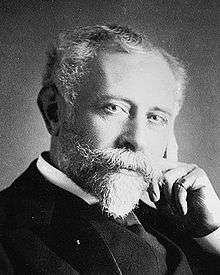
The La Marsa Convention, signed in 1883, by Bey Ali Muddat ibn al-Husayn, formally established the French protectorate. It deprived the Bey of Tunis of control over internal matters by committing him to implement administrative, judicial, and financial reform dictated by France.[11]
In Tunisia: Crossroads of the Islamic and European World, Kenneth J. Perkins writes: "Cambon carefully kept the appearance of Tunisian sovereignty while reshaping the administrative structure to give France complete control of the country and render the beylical government a hollow shell devoid of meaningful powers."[11]
French officials used several methods to control the Tunisian government. They urged the Bey to nominate members of the pre-colonial ruling elite to such key posts as prime-minister, because these people were personally loyal to the Bey and followed his lead in offering no resistance to the French.[12] At the same time the rulers obtained the dismissal of Tunisians who had supported the 1881 rebellion or had otherwise opposed the extension of French influence.[12] A Frenchman held the office of secretary general to the Tunisian government, created in 1883 to advise the prime minister and oversee and coordinate the work of the bureaucracy. French experts answerable only to this secretary general and the Resident-General managed and staffed those government offices, collectively called the Technical Services, which dealt with finances, public works, education, and agriculture.[12] To help him implement the reforms alluded to in the La Marsa Convention, the Resident-General had the power to promulgate executive decrees, reducing the Bey to little more than a figurehead.[12]
Local government
The French authorities left the framework of local government intact, but devised mechanisms to control it. Qaids, roughly corresponding to provincial governors, were the most important figures in local administration.[12] At the outset of the protectorate, some sixty of them had the responsibility of maintaining order and collecting taxes in districts either defined by tribal membership, or by geographical limits. The central government appointed the qaids, usually choosing a person from a major family of the tribe or district to ensure respect and authority. Below the qaids were cheikhs, the leaders of tribes, villages, and town quarters. The central government also appointed them but on the recommendation of the qaids.[12] After the French invasion, most qaids and cheikhs were allowed to retain their post, and therefore few of them resisted the new authorities.[12]
To keep a close watch on developments outside the capital, Tunisia's new rulers organised the contrôleurs civils. These French officials replicated, at the local level, of the Resident-General, closely supervising the qaids and cheikhs.[12] After 1884, a network of contrôleurs civils overlay the qaids' administration throughout the country, except in the extreme south. There, because of the more hostile nature of the tribes and the tenuous hold of the central government, military officers, making up a Service des Renseignements (Intelligence Service), fulfilled this duty.[12] Successive Residents-General, fearing the soldiers' tendency toward direct rule — which belied the official French myth that Tunisians continued to govern Tunisia — worked to bring the Service des Renseignements under their control, finally doing so at the end of the century.[12]
Shoring up the debt-ridden and plundered Tunisian treasury was one of Cambon's main priorities. In 1884, France guaranteed the Tunisian debt, paving the way for the termination of the International Debt Commission's stranglehold on Tunisian finances. Responding to French pressure, the Bey's government then lowered taxes, including the majba. French officials hoped that their careful monitoring of tax assessment and collection procedures would result in a more equitable system stimulating a revival in production and commerce and generating more revenues for the state.[13]
Judicial system
In 1883, French law and French courts were introduced, thereafter French law applied to all French and foreign residents. The other European powers agreed to give up the consular courts they had maintained to protect their nationals from the Tunisian judiciary. The French courts also tried cases in which one litigant was Tunisian, the other European.[13] The protectorate authorities made no attempt to alter Muslim religious courts in which judges, or qadis, trained in Islamic law heard relevant cases.[13] A beylical court handling criminal cases operated under French supervision in the capital. In 1896, similar courts were initiated in the provinces, again under the watchful eye of the French.
Education
The protectorate introduced new ideas in education. The French director of public education looked after all schools in Tunisia, including religious ones.[13] According to Perkins "Many colonial officials believed that modern education would lay the groundwork for harmonious Franco-Tunisia relations by providing a means of bridging the gap between Arabo-Islamic and European cultures". In a more pragmatic vein, schools teaching modern subjects in a European language would produce a cadre of Tunisians with the skills necessary to staff the growing government bureaucracy. Soon after the protectorates establishment, the Directorate of Public Education set up a unitary school system for French and Tunisian pupils designed to draw the two peoples closer together. The French language was the medium of instruction in these Franco-Arab schools, and their curriculum imitated that of schools in metropolitan France. French-speaking students who attended them studied Arabic as a second language. Racial mixing rarely occurred in schools in the cities, in which various religious denominations continued to provide elementary schools. The Franco-Arab schools attained somewhat greater success in rural areas but never enrolled more than a fifth of Tunisia's eligible students. At the summit of the modern education system was Kheireddine's Sadiki College. Highly competitive examinations regulated admission to Sadiki, but its graduates were almost assured government positions by virtue of their training in modern subjects and French.[14]
World War II

Many Tunisians took satisfaction in France's defeat by Germany in June 1940,[15] but the nationalist parties derived no more substantive dividend from the colonial power's humiliation. Despite his commitment to terminate the French protectorate, the pragmatic independence leader Habib Bourguiba had no desire to exchange the control of the French Republic for that of Fascist Italy or Nazi Germany, whose state ideologies he abhorred.[16] He feared that associating with the Axis might bring to the nationalist movement a short-term profit but result in a long-term tragedy.[16] Following the Franco-German armistice, the Vichy Government of Marshal Pétain sent to Tunis as new Resident-General the admiral Jean Esteva, who had no intention of permitting a revival of Tunisian political activity. The arrests of Taieb Slim and Habib Thameur, central figures in the Neo-Destour party's political bureau, was due to this repression. The Bey Muhammad VII al-Munsif moved towards greater independence in 1942 but when the Axis were forced out of Tunisia in 1943, the Free French accused him of collaborating with the Vichy Government and deposed him.
Independence

Decolonisation proved a protracted and controversial affair. In Tunisia, nationalists demanded the return of the deposed Bey and institutional reform.[17] In 1945, the two Destour parties joined other dissident groups to petition for autonomy. The following year, Habib Bourguiba and the Néo-Destour Party switched their aim to complete independence. Fearing arrest, Bourguiba spent much of the next three years in Cairo where in 1950, he issued a seven-point manifesto demanding the restitution of Tunisian sovereignty and election of a national assembly.[17] A conciliatory French government acknowledged the desirability of autonomy, although it warned that this would eventuate only at some unspecified time in the rather distant future; Paris proposed French and Tunisian ”co-sovereignty” over the protectorate. An accord signed the next year, which granted increased powers to Tunisian officials, fell short of satisfying nationalists and outraged settlers. New French prime ministers took a harder line and kept Bourguiba under house arrest from 1951 to 1954.[17] A major general strike in 1952 led to violent confrontation between the French and Tunisians, including guerrilla attacks by nationalists. Yet another change in French government, the appointment of Pierre Mendès-France as prime minister in 1954, brought a return to gentler approaches. International circumstances — the French disaster in Indochina and growing unrest in Algeria — promoted French efforts in to solve the Tunisian question quickly and peacefully. In a speech in Carthage, Mendès-France solemnly proclaimed the autonomy of the Tunisian government, although France retained control of substantial areas of administration. In 1955, Bourguiba returned to Tunis in triumph. At the same time, the French protectorate of Morocco was terminated which further paved way for Tunisian independence, as decolonization gained pace. The next year, the French revoked the clause of the Treaty of Bardo that established the protectorate back in 1881 and recognised the complete independence of the Kingdom of Tunisia under Muhammad VIII al-Amin on 20 March.[18]
See also
| Wikimedia Commons has media related to French Protectorate of Tunisia. |
- List of French residents-general in Tunisia
- History of Tunisia
- History of France
- French Colonial Empire
- List of French possessions and colonies
Notes and references
- Notes
- ↑ Prior to 1890, the French minister of the navy was also head of the Office of the Colonies.
- References
- 1 2 "French Colonization in North Africa". JSTOR 1944685.
- ↑ Wesseling 1996, p. 20
- ↑ Wesseling 1996, pp. 20–21
- 1 2 3 4 5 Wesseling 1996, p. 21
- 1 2 3 Wesseling 1996, p. 22
- ↑ Wesseling 1996, pp. 22–23
- ↑ Ganiage 1985, pp. 174–75
- ↑ Wesseling 1996, p. 9
- ↑ Wesseling 1996, p. 10
- ↑ M. Şükrü Hanioğlu, A Brief History of the Late Ottoman Empire (Princeton University Press, 2008), 9–10 and 69.
- 1 2 Perkins 1986, p. 86.
- 1 2 3 4 5 6 7 8 9 10 Perkins 1986, p. 87.
- 1 2 3 4 Perkins 1986, p. 88.
- ↑ Perkins 1986, pp. 88–89.
- ↑ Perkins 2004, p. 105.
- 1 2 Perkins 1986, p. 180.
- 1 2 3 Aldrich 1996, p. 289.
- ↑ Aldrich 1996, p. 290.
- Bibliography
- Aldrich, Robert (1996). Greater France. A history of French Expansion. Macmillan Press. ISBN 0-333-56740-4.
- Ganiage, Jean (1985). "North Africa". In Olivier, Roland; Fage, J. D.; Sanderson, G. N. The Cambridge History of Africa: From 1870 to 1905. VI. Cambridge University Press. ISBN 0-521-22803-4.
- Perkins, Kenneth J. (2004). A History of Modern Tunisia. Cambridge University Press. ISBN 0-521-81124-4.
- Perkins, Kenneth J. (1986). Tunisia. Crossroads of the Islamic and European World. Westview Press. ISBN 0-7099-4050-5.
- Wesseling, Henk (1996) [1991]. Verdeel en heers. De deling van Afrika, 1880–1914 [Divide and Rule: The Partition of Africa, 1880–1914]. Arnold J. Pomerans (trans.). Praeger (Greenwood Publishing Group). ISBN 0-275-95138-3.
Further reading
- Andrew, Christopher. M.; Kanya-Forstner, A. S. (1971). "The French 'Colonial Party'. Its Composition, Aims and Influences". Historical Journal (14): 99–128.
- Andrew, Christopher. M.; Kanya-Forstner, A. S. (1976). "French Business and the French Colonialist". Historical Journal (17): 837–866.
- Andrew, Christopher. M.; Kanya-Forstner, A. S. (1974). "The groupe colonial in the French Chamber of Deputies, 1892-1932". Historical Journal (19): 981–1000.
- Andrew, Christopher. M.; Kanya-Forstner, A. S. (1981). France Overseas. The Great War and the Climax of French Imperialism.
- Cohen, William B. (1971). Rulers of Empire. The French Colonial Service in Africa. Hoover Institution Press.
- Broadley, A. M. (1881). The Last Punic War: Tunis, Past and Present. I. William Blackwood and Sons.
- Broadley, A. M. (1882). The Last Punic War: Tunis, Past and Present. II. William Blackwood and Sons.
- Issawi, Charles (1982). An economic History of the Middle East and North Africa. Columbia University Press. ISBN 0-231-03443-1.
- Langer, W. (1925–1926). "The European Powers and the French Occupation of Tunis, 1878–1881". American Historical Review (31): 55–79 & 251–256.
- Ling, Dwight L. (1979). Morocco and Tunisia, a Comparative History. University Press of America. ISBN 0-8191-0873-1.
- Murphy, Agnès (1948). The Ideology of French Imperialism, 1871–1881. Catholic University of America Press.
- Pakenham, Thomas (1991). The Scramble for Africa. Weidenfield and Nicolson. ISBN 0-297-81130-4.
- Persell, Stewart Michael (1983). The French Colonial Lobby, 1889–1938. Stanford University Press.
- Priestly, Herbert Ingram (1938). France Overseas. A study of Modern Imperialism.
- Roberts, Stephen Henry (1929). History of French Colonial Policy, 1870–1925.
- Wilson, Henry S. (1994). African Decolonization. Hooder Headline. ISBN 0-340-55929-2.
Coordinates: 36°50′00″N 10°09′00″E / 36.8333°N 10.1500°E
